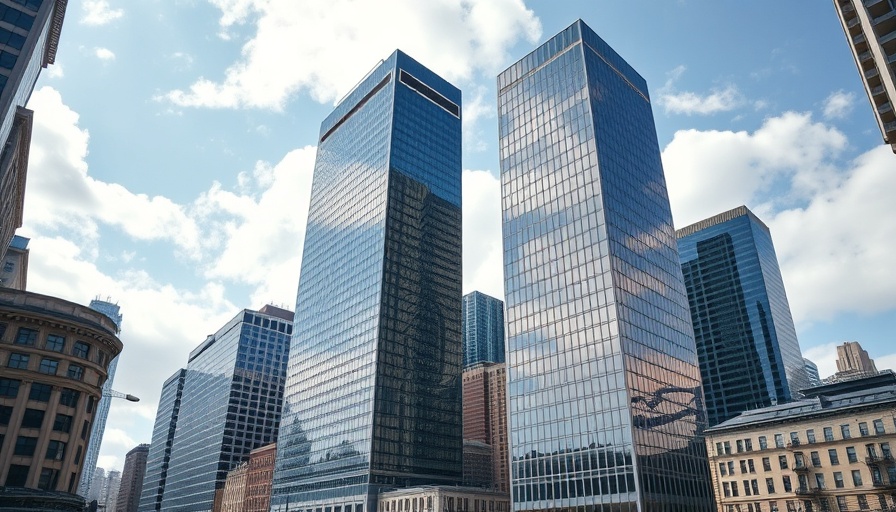
New York Life’s Strategic Move into San Francisco’s Office Market
In a striking turn of events for San Francisco's real estate landscape, New York Life’s Real Estate Investors, in collaboration with the Dallas-based Lincoln Property Co., has made tactical headway by acquiring a distressed loan related to the 23-story office tower at 353 Sacramento St. This acquisition marks their third post-pandemic investment in a market that has been previously sidelined by major investors. Available for a substantial discount, the $62.2 million acquisition of the loan—down from the $169.5 million that Pacific Oak Strategic Opportunity REIT paid nine years ago—reflects the rising interest of institutional investors as they recognize potential value in a historically fraught market.
Market Recovery Prospects: A Snapshot
With approximately two-thirds of the 284,751-square-foot tower vacant, the deal may appear risky at first glance. However, experts reveal underlying potential. The property was never foreclosed, and this absence of foreclosure suggests the opportunity for revitalization. The current market landscape shows a shift, where institutional investors like New York Life are beginning to see possibility among the challenges post-pandemic. Most notably, the company is considering another acquisition, the building at 600 Townsend West, which could further diversify their portfolio in the area.
Historical Context: San Francisco’s Real Estate Turbulence
Historically, San Francisco has seen a volatile real estate market, especially post-Great Recession and now through the pandemic. This recent trend of discounted sales suggests an evolving market as institutional players like New York Life start to re-enter. The pandemic caused significant changes in workplace habits, leading to a steep decline in demand for office spaces in the city. According to the San Francisco Business Times, significant properties have remained largely vacant, indicating a period where local and international investors hesitated.
Counterarguments: Risks in Investing Now
Despite the optimism reflected in recent acquisitions, there are also potential pitfalls. Some analysts caution that the office market may not rebound as expected. Many companies have adopted remote work policies permanently, significantly reducing the utility of traditional office spaces. Critics argue that institutions may be overestimating the long-term viability of investing in San Francisco's office market.
Future Predictions: What Lies Ahead?
The unfolding narrative in San Francisco raises several questions about the future of office space in urban areas. Industry experts forecast incremental recoveries, suggesting that the market might stabilize as the pandemic’s impacts diminish. However, how rapidly San Francisco's office market rebounds will depend on several factors, including the adaptation of hybrid work models and the continuous evolution of workplace needs.
What Does This Mean for Local Residents?
Residents and workers in the Bay Area may find hope in the resurgence of institutional interest in local real estate, potentially leading to revamped business districts. With more companies looking to adapt their office spaces to modern norms, there can be a fresh influx of jobs and economic activity.
This can only be beneficial for the local economy, as new office developments can bring not only jobs but an increase in service demands, ranging from local coffeehouses to retail services. The revitalization of neighborhoods can breed a renewed sense of community and opportunity.
Engaging Reflection: Why These Developments Matter
The actions of institutional investors like New York Life can serve as a litmus test for the Bay Area’s real estate recovery. As these players are often at the helm of transformative change in urban settings, the implications of their entries point towards a broader story of resilience and adaptation—key themes as cities like San Francisco navigate out of the pandemic's shadow.
For those influenced by the realities of urban living and investment, understanding these trends provides not just insight but also the ability to anticipate changes that might directly affect their daily lives, careers, and the broader economic fabric of their communities.
As the situation evolves, staying informed about such transactions and the experts’ insights can enable residents, businesses, and investors alike to navigate this changing landscape more effectively.
For those curious about the latest developments in San Francisco's real estate scene and how they echo across the broader economic climate—your engagement and responsiveness to these trends may shape your future decisions in this dynamic environment.
 Add Row
Add Row  Add
Add 




Write A Comment